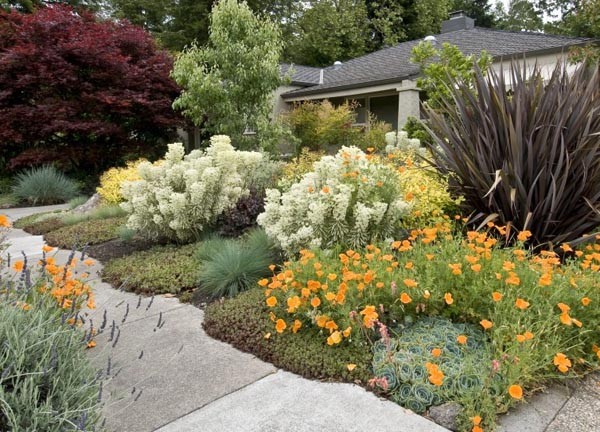Change your landscaping and reduce water use
By Melody Huskey
Greener Environments Landscaping

Photo courtesy of Greener Environments Landscaping.
The changing landscape of the California drought
With our water at record breaking lows, many people are envisioning that California’s future landscape will look like Las Vegas or Arizona. If we continue to irrigate our water loving lawns as if we were not in a drought, this could be the case. However, if we all take action now to make changes to our landscapes and reduce our water use, we may be able to keep this state looking green and beautiful. Since lawns require heavy irrigation, Governor Jerry Brown plans to replace 50 million square feet of lawns with drought tolerant plants is a responsible move that will help us save tons of water.
This area of California has a mediterranean climate, which is characterized by long, hot, dry summers, and mild winters. Many of the plants that have adapted to survive in mediterranean climates are sclerophyllous, meaning they have small hard leaves with a waxy coating to retain water in the dry months. These plants will survive and stay green in hot summers without irrigation. The best part is that so many of these plants are beautiful and interesting.
Imagine what your yard would look like if you took out your lawn and replaced it with shady oak trees to sit under and fragrant sages that welcomed hummingbirds. The exposed red bark of Manzanita could be surrounded by the purple and orange carpet of lupine and California poppy. The point is, that you don’t need to think of the removal of your lawn as a sacrifice, but rather a beautification and a return to nature.
Having said all of this, I do understand the desire to have a lawn. And I realize that many of you will hold on to your lush green lawn, no matter what I or the governor may say. So if you can’t seem to let go, there are ways you can reduce how much water your lawn uses. For example: only water your lawn when it appears thirsty; you can tell your lawn needs water when it takes on a gray green tinge, or if you step on your lawn and the blades of grass don’t bounce back. Other ways for reducing water usage on your lawn include keeping your grass a little bit taller, watering early in the morning or late at night, and not watering when it is windy. Also check to make sure your sprinklers are watering the lawn only and not the sidewalk. Now is a great time to have a professional come and look at your sprinkler system to make sure there are no leaks and you are only using as much water as is needed.
Now for the happy medium: if you are uncomfortable with the amount of water it takes to keep your current lawn, but you still want to have that “lawn look,” you can use different varieties of grass than the commonly used thirstier varieties. Carex glauca—common name blue sedge— is a perennial grass that can handle drought conditions in well drained soil. It’s grayish-green foliage will stick around in the winter and provide your landscape with a more natural looking type of lawn. Buffalo grass is also very drought resistant. Although it will turn tan in the colder months, it will provide you with a green lawn during the summer with very little water. Carex subfusca, or rusty sedge, is an evergreen native grass. It spreads and gives a beautiful lush lawn look. It can be mowed or left to grow to 1 foot. Other drought tolerant ground covers include Roman chamomile, cotoneaster, myoporum, common thyme, and creeping thyme, to name a few.
There are other alternatives to plants, and grasses that require no water usage at all. Dry creek beds are becoming increasingly popular in the landscape and can take up a good portion of space that will require no water. Consider replacing your lawn with a patio of flagstone or brick. Also, mulch is a very inexpensive way to replace uncovered ground with a cleaner, more finished look. If you have replaced your lawn with native plants, be sure to mulch around the plants. Mulching around existing plants can save up to 25 percent of the water your plants will need. As the summer sets in here on the Central Coast during one of the worst droughts in California history, now is a good time to think about taking steps to reduce your water usage. Fortunately, that doesn’t mean you have to give up your beautiful landscape.






















